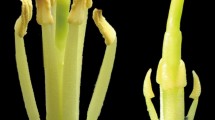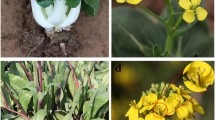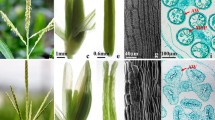Abstract
Flower development is essential for the sexual reproduction and crop yield of plants. Thus, a better understanding of plant sterility from the perspective of morphological and molecular genetics is imperative. In our previous study, a recessive female-sterile Chinese cabbage mutant fsm was obtained from a doubled haploid line ‘FT’ via an isolated microspore culture combined with EMS mutagenesis. Pistil aniline blue staining and stigma scanning observation showed that the growth of the stigma papillar cells and pollen tubes of the mutant fsm were normal. Therefore, the female sterility was due to abnormal development of the ovules. To map the mutant fsm, 3108 F2 individuals were selected for linkage analysis. Two closely linked markers, Indel-I2 and Indel-I7, were localized on the flanking region of fsm at distances of 0.05 cM and 0.06 cM, respectively. The physical distance between Indel-I2 and Indel-I7 was ~ 1376 kb, with 107 genes remaining in the target region. This region was located on the chromosome A04 centromere, on which low recombination rates and a high frequency of repetitive sequences were present. Whole-genome re-sequencing detected a single-nucleotide (C-to-A) transition (TCG/TAG) on the exon of BraA04001030, resulting in a premature stop codon. Genotyping revealed that the female-sterile phenotype was fully cosegregated with this SNP. BraA04001030 encodes a homologue of STERILE APETALA (SAP) transcriptional regulator, which plays vital roles in floral development. The results of the present study suggest that BraA04001030 is a strong candidate gene for fsm and provide the basis for exploring the molecular mechanism underlying female sterility in Chinese cabbage.





Similar content being viewed by others
References
Anastasiou E, Kenz S, Gerstung M, MacLean D, Timmer J, Fleck C, Lenhard M (2007) Control of plant organ size by KLUH/CYP78A5-dependent intercellular signaling. Dev Cell 13:843–856. https://doi.org/10.1016/j.devcel.2007.10.001
Bencivenga S, Colombo L, Masiero S (2011) Cross talk between the sporophyte and the megagametophyte during ovule development. Sex Plant Reprod 24:113–121. https://doi.org/10.1007/s00497-011-0162-3
Bowman JL, Smyth DR, Meyerowitz EM (1989) Genes directing flower development in Arabidopsis. Plant Cell 1:37–52. https://doi.org/10.1105/tpc.1.1.37
Byzova MV, Franken J, Aarts MG, de AlmeidaEngler J, Engler G, Mariani C, Van Lookeren Campaqne MM, Angenent GC (1999) Arabidopsis STERILE AAPETALA, a multifunctional gene regulating inflorescence, flower, and ovule development. Genes Dev 13:1002–1014. https://doi.org/10.1101/gad.13.8.1002
Cao L, Wang S, Venglat P, Zhao L, Cheng Y, Ye S, Qin Y, Datla R, Zhou Y, Wang H (2018) Arabidopsis ICK/KRP cyclin-dependent kinase inhibitors function to ensure the formation of one megaspore mother cell and one functional megaspore per ovule. PLoS Genet 14:e1007230. https://doi.org/10.1371/journal.pgen.1007230
Chatterjee M, Tabi Z, Galli M, Malcomber S, Buck A, Muszynski M, Gallavotti A (2014) The boron efflux transporter ROTTEN EAR is required for maize inflorescence development and fertility. Plant Cell 26:2962–2977. https://doi.org/10.1105/tpc.114.125963
Chen YH, Li HJ, Shi DQ, Yuan L, Liu J, Sreenivasan R, Baskar R, Grossniklaus U, Yang WC (2007) The central cell plays a critical role in pollen tube guidance in Arabidopsis. Plant Cell 19:3563–3577. https://doi.org/10.1105/tpc.107.053967
Chen L, Zhang J, Li H, Niu J, Xue H, Liu B, Wang Q, Luo X, Zhang F, Zhao D, Cao S (2017) Transcriptomic analysis reveals candidate genes for female sterility in pomegranate flowers. Front Plant Sci 8:1430. https://doi.org/10.3389/fpls.2017.01430
Cheng Z, Dong F, Langdon T, Ouyang S, Buell CR, Gu M, Blattner FR, Jiang J (2002) Functional rice centromeres are marked by a satellite repeat and a centromere-specific retrotransposon. Plant Cell 14:1691–1704. https://doi.org/10.1105/tpc.003079
Cheng F, Mandáková T, Wu J, Xie Q, Lysak MA, Wang X (2013) Deciphering the diploid ancestral genome of the Mesohexaploid Brassica rapa. Plant Cell 25:1541–1554. https://doi.org/10.1105/tpc.113.110486
Coen ES, Meyerowitz EM (1991) The war of the whorls: genetic interactions controlling flower development. Nature 353:31–37. https://doi.org/10.1038/353031a0
Drews GN, Bowman JL, Meyerowitz EM (1991) Negative regulation of the Arabidopsis homeotic gene AGAMOUS by the APETALA2 product. Cell 65:991–1002. https://doi.org/10.1016/0092-8674(91)90551-9
Du L, Li N, Chen L, Xu Y, Li Y, Zhang Y, Li C, Li Y (2014) The ubiquitin receptor DA1 regulates seed and organ size by modulating the stability of the ubiquitin-specific protease UBP15/SOD2 in Arabidopsis. Plant Cell 26:665–677. https://doi.org/10.1105/tpc.114.122663
Elliott RC, Betzner AS, Huttner E, Oakes MP, Tucker WQ, Gerentes D, Pere P, Smyth DR (1996) AINTEGUMENTA, an APETALA2-like gene of Arabidopsis with pleiotropic roles in ovule development and floral organ growth. Plant Cell 8:155–168. https://doi.org/10.2307/3870261
Eshed Y, Baum SF, Perea JV, Bowman JL (2001) Establishment of polarity in lateral organs of plants. Curr Biol 11:1251–1260. https://doi.org/10.1016/S0960-9822(01)00392-X
Gray WM, Kepinski S, Rouse D, Leyser O, Estelle M (2001) Auxin regulates SCFTIR1-dependent degradation of AUX/IAA proteins. Nature 414:271–276. https://doi.org/10.1038/35104500
Gremski K, Ditta G, Yanofsky MF (2007) The HECATE genes regulate female reproductive tract development in Arabidopsis thaliana. Development 134:3593–3601. https://doi.org/10.1016/j.jfluchem.2006.06.018
Groß-Hardt R, Lenhard M, Laux T (2002) WUSCHEL signaling functions in interregional communication during Arabidopsis ovule development. Genes Dev 16:1129–1138. https://doi.org/10.1101/gad.225202
Harloff HJ, Lemcke S, Mittasch J, Frolov A, Wu JG, Dreyer F, Leckband G, Junq C (2012) A mutation screening platform for rapeseed (Brassica napus, L.) and the detection of sinapine biosynthesis mutants. Theor Appl Genet 124:957–969. https://doi.org/10.1007/s00122-011-1760-z
Hu Y, Xie Q, Chua NH (2003) The Arabidopsis auxin-inducible gene ARGOS controls lateral organ size. Plant Cell 15:1951–1961. https://doi.org/10.1105/tpc.013557
Hu Y, Poh HM, Chua NH (2006) The Arabidopsis ARGOS-LIKE gene regulates cell expansion during organ growth. Plant J 47:1–9. https://doi.org/10.1111/j.1365-313X.2006.02750.x
Hu L, Liang W, Yin C, Cui X, Zong J, Wang X, Hu J, Zhang D (2011) Rice MADS3 regulates ROS homeostasis during late anther development. Plant Cell 23:515–533. https://doi.org/10.1105/tpc.110.074369
Huang SN, Liu ZY, Li CY, Yao RP, Li DY, Hou L, Li X, Liu WJ, Feng H (2017) Transcriptome analysis of a female-sterile mutant (fsm) in Chinese cabbage (Brassica campestris ssp. pekinensis). Front Plant Sci 8:546. https://doi.org/10.3389/fpls.2017.00546
Ito T, Wellmer F, Yu H, Das P, Ito N, Alves-ferreira M, Riechmann JL, Meyerowitz EM (2004) The homeotic protein AGAMOUS controls microsporogenesis by regulation of SPOROCYTELESS. Nature 430:356–360. https://doi.org/10.1038/nature02733
Ito T, Ng KH, Lim TS, Yu H, Meyerowitz EM (2007) The homeotic protein AGAMOUS controls late stamen development by regulating a jasmonate biosynthetic gene in Arabidopsis. Plant Cell 19:3516–3529. https://doi.org/10.1105/tpc.107.055467
Kang S, Kim BG, Han HH, Lee JH, Kim JE, Shim HS, Cho NH (2015) Targeted sequencing with enrichment PCR: a novel diagnostic method for the detection of EGFR mutations. Oncotarget 6:13742–13749. https://doi.org/10.18632/oncotarget.3807
Kater MM, Dreni L, Colombo L (2006) Functional conservation of MADS-box factors controlling floral organ identity in rice and Arabidopsis. J Exp Bot 57:3433. https://doi.org/10.1093/jxb/erl097
Kaufmann K, Muiño JM, Jauregui R, Airoldi CA, Smaczniak C, Krajewski P, Angenent GC (2009) Target genes of the MADS transcription factor SEPALLATA3: integration of developmental and hormonal pathways in the Arabidopsis flower. PLoS Biol 7:e1000090. https://doi.org/10.1371/journal.pbio.1000090
Kim JH, Kende H (2004) A transcriptional coactivator, AtGIF1, is involved in regulating leaf growth and morphology in Arabidopsis. Proc Natl Acad Sci USA 101:13374–13379. https://doi.org/10.1073/pnas.0405450101
Kim GT, Tsukaya H, Uchimiya H (1998) The ROTUNDIFOLIA3 gene of Arabidopsis thaliana encodes a new member of the cytochrome P-450 family that is required for the regulated polar elongation of leaf cells. Genes Dev 12:2381–2391. https://doi.org/10.1101/gad.12.15.2381
Kim JH, Choi D, Kende H (2003) The AtGRF family of putative transcription factors is involved in leaf and cotyledon growth in Arabidopsis. Plant J 36:94–104. https://doi.org/10.1046/j.1365-313X.2003.01862.x
Klucher KM, Chow H, Reiser L, Fischer RL (1996) The AINTEGUMENTA gene of Arabidopsis required for ovule and female gametophyte development is related to the floral homeotic gene APETALA2. Plant Cell 8:137–153. https://doi.org/10.1105/tpc.8.2.137
Kosambi DD (1943) The estimation of map distances from recombination values. Ann Eugenics 12(1):172–175
Krizek BA (1999) Ectopic expression of AINTEGUMENTA in Arabidopsis plants results in increased growth of floral organs. Dev Genet 25:224–236. https://doi.org/10.1002/(SICI)1520-6408(1999)25:3%3c224:AID-DVG5%3e3.0.CO;2-Y
Kuusk S, Sohlberg JJ, Lonq JA, Fridborg I, Sundberg E (2002) STY1 and STY2 promote the formation of apical tissues during Arabidopsis gynoecium development. Development 129:4707–4717. https://doi.org/10.1007/s00429-002-0268-3
Lander ES, Green P, Abrahamson J, Barlow A, Daly MJ, Lincoln SE, Newberg LA (1987) MAPMAKER: an interactive computer package for constructing primary genetic linkage maps of experimental and natural populations. Genomics 1:174–181. https://doi.org/10.1016/j.ygeno.2008.12.003
Lee KH, Minami A, Marshall RS, Book AJ, Farmer LM, Walker JM, Vierstra RD (2011) The RPT2 subunit of the 26S proteasome directs complex assembly, histone dynamics, and gametophyte and sporophyte development in Arabidopsis. Plant Cell 23:4298–4317. https://doi.org/10.1105/tpc.111.089482
Lee DS, Chen LJ, Li CY, Liu Y, Tan XL, Lu BR, Li J, Gan SX, Kang SG, Suh HS, Zhu Y (2013) The Bsister MADS Gene FST determines ovule patterning and development of the zygotic embryo and endosperm. PLoS ONE 8:e58748. https://doi.org/10.1371/journal.pone.0058748
Li SC, Yang L, Deng QM, Wang SQ, Wu FQ, Li P (2006) Phenotypic characterization of a female sterile mutant in rice. J Integr Plant Biol 48:307–314. https://doi.org/10.1111/j.1744-7909.2006.00228.x
Li Y, Zheng L, Corke F, Smith C, Bevan MW (2008) Control of final seed and organ size by the DA1 gene family in Arabidopsis thaliana. Genes Dev 22:1331–1336. https://doi.org/10.1101/gad.463608
Li N, Liu Z, Wang Z, Ru L, Gonzalez N, Baekelandt A, Pauwels L, Goossens A, Xu R, Zhu Z, Inzé D, Li Y (2018) STERILE APETALA modulates the stability of a repressor protein complex to control organ size in Arabidopsis thaliana. PLoS Genet 14:e1007218. https://doi.org/10.1371/journal.pgen.1007218
Liljegren SJ, Ditta GS, Eshed Y, Savidqe B, Bowman JL, Yanofsky MF (2000) SHATTERPROOF MADS-box genes control seed dispersal in Arabidopsis. Nature 404:766–770. https://doi.org/10.1038/35008089
Liu N, Wu S, Van Houten J, Wang Y, Ding B, Fei Z, Clarke TH, Reed JW, van der Knaap E (2014) Down-regulation of AUXIN RESPONSE FACTORS 6 and 8 by microRNA 167 leads to floral development defects and female sterility in tomato. J Exp Bot 65:2507–2520. https://doi.org/10.1093/jxb/eru141
Liu H, Wu Y, Cao A, Mao B, Zhao B, Wang J (2017) Genome-wide analysis of DNA methylation during ovule development of female-sterile rice fsv1. G3 7:3621–3635. https://doi.org/10.1534/g3.117.300243
Liu S, Zhang Y, Feng Q, Qin L, Pan C, Lamin-Samu AT, Lu G (2018) Tomato AUXIN RESPONSE FACTOR 5 regulates fruit set and development via the mediation of auxin and gibberellin signaling. Sci Rep 8:2971. https://doi.org/10.1038/s41598-018-21315-y
Livak KJ, Schmittgen TD (2001) Analysis of relative gene expression data using real-time quantitative PCR and the 2(−Delta Delta C (T)) method. Methods 25:402–408. https://doi.org/10.1006/meth.2001.1262
Lu D, Wang T, Persson S, Mueller-Roeber B, Schippers JH (2014) Transcriptional control of ROS homeostasis by KUODA1 regulates cell expansion during leaf development. Nat Commun 5:3767. https://doi.org/10.1038/ncomms4767
McAbee JM, Hill TA, Skinner DJ, Izhaki A, Hauser BA, Meister RJ, Venuqopala Reddy G, Meyerowitz EM, Bowman JL, Gasser CS (2006) ABERRANT TESTA SHAPE encodes a KANADI family member, linking polarity determination to separation and growth of Arabidopsis ovule integuments. Plant J 46:522–531. https://doi.org/10.1111/j.1365-313X.2006.02717.x
Nath U, Crawford BC, Carpenter R, Coen E (2003) Genetic control of surface curvature. Science 299:1404–1407. https://doi.org/10.1126/science.1079354
Nemhauser JL, Feldman LJ, Zambryski PC (2000) Auxin and ETTIN in Arabidopsis gynoecium morphogenesis. Development 127:3877–3888. https://doi.org/10.1002/1097-0320(20000901)41:1%3c73:AID-CYTO10%3e3.0.CO;2-5
Pagnussat GC, Alandete-Saez M, Bowman JL, Sundaresan V (2009) Auxin-dependent patterning and gamete specification in the Arabidopsis female gametophyte. Science 324:1684–1689. https://doi.org/10.1126/science.1167324
Pinyopich A, Ditta GS, Savidge B, Liljegren SJ, Baumann E, Wisman E, Yanofsky MF (2003) Assessing the redundancy of MADS-box genes during carpel and ovule development. Nature 424:85–88. https://doi.org/10.1038/nature01741
Scott RJ, Spielman M, Dickinson HG (2004) Stamen structure and function. Plant Cell 16:S46–S60. https://doi.org/10.1016/j.laa.2009.09.016
Serrat X, Esteban R, Guibourt N, Moysset L, Nogués S, Lalanne E (2014) EMS mutagenesis in mature seed-derived rice calli as a new method for rapidly obtaining TILLING mutant populations. Plant Methods 10:5. https://doi.org/10.1186/1746-4811-10-5
Siddiqi I, Ganesh G, Grossniklaus U, Subbiah V (2000) The dyad gene is required for progression through female meiosis in Arabidopsis. Development 127:197–207. https://doi.org/10.1002/jcla.2062
Sikora P, Chawade A, Larsson M, Olsson J, Olsson O (2011) Mutagenesis as a tool in plant genetics, functional genomics, and breeding. Int J Plant Genomics 2011:314829. https://doi.org/10.1155/2011/314829
Singh SK, Kumar V, Srinivasan R, Ahuja PS, Bhat SR, Bhat SR, Sreenivasulu Y (2017) The TRAF Mediated Gametogenesis Progression (TRAMGaP) gene is required for megaspore mother cell specification and gametophyte development. Plant Physiol 175:1220–1237. https://doi.org/10.1104/pp.17.00275
Spartz AK, Lee SH, Wenger JP, Gonzalez N, Itoh H, Inzé D, Peer WA, Murphy AS, Overvoorde PJ, Gray WM (2012) The SAUR19 subfamily of SMALL AUXIN UP RNA genes promote cell expansion. Plant J 70:978–990. https://doi.org/10.1111/j.1365-313X.2012.04946.x
Sugimoto-Shirasu K, Roberts K (2003) ‘Big it up’: endoreduplication and cell-size control in plants. Curr Opin Plant Biol 6:544–553. https://doi.org/10.1016/j.pbi.2003.09.009
Sundaresan V, Alandetesaez M (2010) Pattern formation in miniature: the female gametophyte of flowering plants. Development 137:179–189. https://doi.org/10.1242/dev.030346
Szécsi J, Joly C, Bordji K, Varaud E, Cock JM, Dumas C, Bendahmane M (2006) BIGPETALp, a bHLH transcription factor is involved in the control of Arabidopsis petal size. EMBO J 25:3912–3920. https://doi.org/10.1038/sj.emboj.7601270
Tedder A, Helling M, Pannell JR, Shimizu-Inatsugi R, Kawagoe T, Campen J, Sese J, Shimizu KK (2015) Female sterility associated with increased clonal propagation suggests a unique combination of androdioecy and asexual reproduction in populations of Cardamine amara (Brassicaceae). Ann Bot 15:763–776. https://doi.org/10.1093/aob/mcv006
Wang N, Wang Y, Tian F, King GJ, Zhang C, Long Y, Shi L, Meng J (2008) A functional genomics resource for Brassica napus: development of an EMS mutagenized population and discovery of FAE1 point mutations by TILLING. New Phytol 180:751–765. https://doi.org/10.1111/j.1469-8137.2008.02619.x
Wang Z, Li N, Jiang S, Gonzalez N, Huang X, Wang Y, Inzé D, Li Y (2016) SCFSAP controls organ size by targeting PPD proteins for degradation in Arabidopsis thaliana. Nat Commun 7:11192. https://doi.org/10.1038/ncomms11192
Wei B, Zhang J, Pang C, Yu H, Guo D, Jiang H, Ding M, Chen Z, Tao Q, Gu H, Qu LJ, Qin G (2015) The molecular mechanism of SPOROCYTELESS/NOZZLE in controlling Arabidopsis ovule development. Cell Res 25:121–134. https://doi.org/10.1038/cr.2014.145
Xia T, Li N, Dumenil J, Li J, Kamenski A, Bevan MW, Gao F, Li YH (2013) The ubiquitin receptor DA1 interacts with the E3 ubiquitin ligase DA2 to regulate seed and organ size in Arabidopsis. Plant Cell 25:3347–3359. https://doi.org/10.1105/tpc.113.115063
Xu R, Li Y (2012) The mediator complex subunit 8 regulates organ size in Arabidopsis thaliana. Plant Signal Behav 7:182–183. https://doi.org/10.4161/psb.18803
Yang L, Wu Y, Yu M, Mao B, Zhao B, Wang J (2016) Genome-wide transcriptome analysis of female-sterile rice ovule shed light on its abortive mechanism. Planta 244:1011–1028. https://doi.org/10.1007/s00425-016-2563-x
Zhou HC, Jin L, Li J, Wang XJ (2016) Altered callose deposition during embryo sac formation of multi-pistil mutant (mp1) in Medicago sativa. Genet Mol Res. https://doi.org/10.4238/gmr.15027968
Funding
The research was supported by the National Natural Science Foundation of China (Grant No. 31672144).
Author information
Authors and Affiliations
Corresponding author
Additional information
Publisher's Note
Springer Nature remains neutral with regard to jurisdictional claims in published maps and institutional affiliations.
Electronic supplementary material
Below is the link to the electronic supplementary material.
497_2019_368_MOESM1_ESM.tif
Alignment of nucleotide sequences of BraA04001030 between seven recombinant individuals, female-sterile mutant fsm, and wild-type ‘FT’ (TIFF 5158 kb)
497_2019_368_MOESM2_ESM.tif
Phylogenetic tree of SAP homologs. The phylogenetic tree was constructed using the neighbor-joining method of MEGA 5.0 program. The scale bar at bottom represents the genetic distance (TIFF 3223 kb)
Rights and permissions
About this article
Cite this article
Liu, W., Huang, S., Liu, Z. et al. A missense mutation of STERILE APETALA leads to female sterility in Chinese cabbage (Brassica campestris ssp. pekinensis). Plant Reprod 32, 217–228 (2019). https://doi.org/10.1007/s00497-019-00368-7
Received:
Accepted:
Published:
Issue Date:
DOI: https://doi.org/10.1007/s00497-019-00368-7




